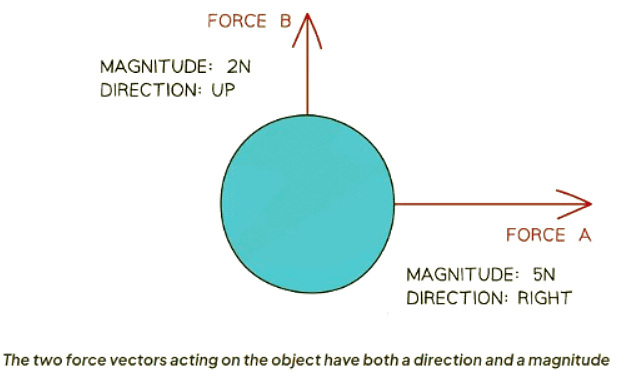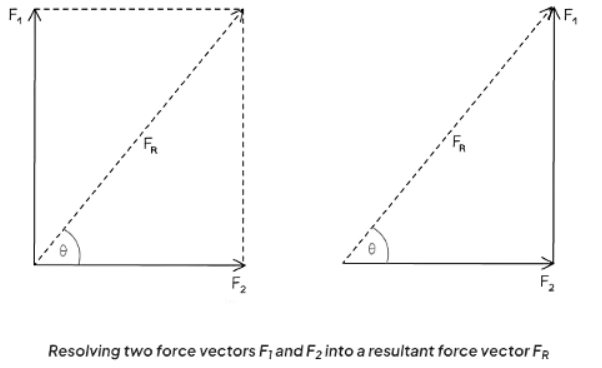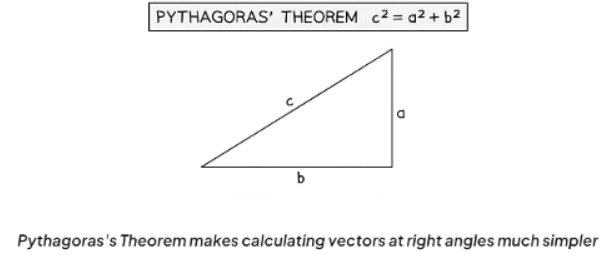Year 11 Exam > Year 11 Notes > Physics for GCSE/IGCSE > Calculating with Vectors
Calculating with Vectors | Physics for GCSE/IGCSE - Year 11 PDF Download
Calculations with Vectors
- Vectors are represented by an arrow. The arrowhead indicates the direction of the vector, and the length of the arrow represents the magnitude.

- Component vectors are often depicted with a dotted line and a subscript denoting horizontal or vertical elements. For instance, Fv represents the vertical component of the force F.
Calculating Vectors Graphically
- To compute vectors graphically, it involves creating a precise scale drawing with accurate lengths and angles. This task necessitates a sharp pencil, ruler, and protractor for accuracy.
Calculations with Vectors on Graphs
- Follow these steps to carry out calculations with vectors on graphs:
- Choose a suitable scale for your diagram, for example, 1 cm = 10 m or 1 cm = 1 N, ensuring the diagram is approximately 10 cm high.
- Draw the vectors perpendicular to each other.
- Complete a rectangle using the vectors.
- Draw the resultant vector from the origin to complete the diagram.
- Measure the length of the resultant vector accurately.
- Use the scale factor to determine the magnitude of the vector.
- Employ a protractor to measure the angle of the vector.
- Ensure that the vectors are drawn at right angles to each other.
- Measure the length of the resultant vector carefully.
- Calculate the magnitude of the vector using the scale factor.
- Determine the angle of the vector using a protractor.

Question for Calculating with VectorsTry yourself: How can vectors be represented graphically?View Solution
Combining Vectors by Calculation
- Although a diagram remains crucial in this approach, it doesn't have to be precisely to scale.
- The diagram can be presented as a sketch, provided that the resultant, component, and sides are clearly labeled.


- Utilize Pythagoras' Theorem to determine the resultant vector.

- Apply trigonometry to ascertain the angle.
- The acronym 'soh-cah-toa' aids in recalling the application of sines and cosines for solving triangle sides.

The document Calculating with Vectors | Physics for GCSE/IGCSE - Year 11 is a part of the Year 11 Course Physics for GCSE/IGCSE.
All you need of Year 11 at this link: Year 11
|
127 videos|148 docs|35 tests
|
FAQs on Calculating with Vectors - Physics for GCSE/IGCSE - Year 11
| 1. How can vectors be calculated graphically? |  |
Ans. Vectors can be calculated graphically by representing them as arrows in a coordinate system. The magnitude of the vector is represented by the length of the arrow, and the direction is indicated by the orientation of the arrow.
| 2. What are some common operations that can be performed with vectors? |  |
Ans. Common operations that can be performed with vectors include addition, subtraction, scalar multiplication, finding the magnitude, and finding the dot product.
| 3. How can vectors be added or subtracted graphically? |  |
Ans. Vectors can be added graphically by placing the tail of the second vector at the head of the first vector and drawing a new vector from the tail of the first vector to the head of the second vector. Subtraction is similar but involves adding the negative of the vector to be subtracted.
| 4. What is the significance of finding the magnitude of a vector? |  |
Ans. The magnitude of a vector represents its length or size. It is important in determining the total distance or displacement represented by a vector and is used in various calculations in physics and engineering.
| 5. How is the dot product of two vectors calculated and what does it represent? |  |
Ans. The dot product of two vectors is calculated by multiplying the magnitudes of the vectors, the cosine of the angle between them, and the direction. It represents the projection of one vector onto another and is used in various applications such as calculating work done by a force.
Related Searches





















